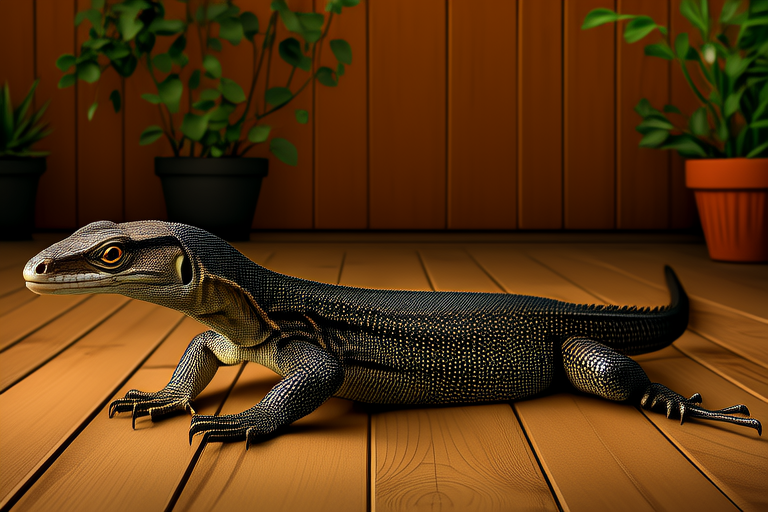From Jungle to Home: Caring for Your Water Monitor Pet
Welcome to the world of water monitors, a fascinating reptile species native to Southeast Asia. Known for their impressive size and unique behaviors, these creatures can make rewarding pets for dedicated owners. This guide will walk you through every aspect of caring for a water monitor, from setting up their habitat to understanding their dietary needs and ensuring their well-being.
Water Monitor Habitat Setup
The first step in caring for your water monitor is creating an appropriate habitat. In the wild, these animals live in diverse environments ranging from dense jungles to coastal mangroves. To mimic this, your water monitor’s enclosure should be large enough to allow for ample movement and exploration. A minimum tank size of 12 feet by 6 feet by 6 feet is recommended for adults, with a substrate that mimics the soil or sand found in their natural habitats.
Temperature control is crucial; water monitors need a basking area heated to around 95-100 degrees Fahrenheit and cooler areas that hover between 75-85 degrees. UVB lighting is also essential, providing the necessary vitamin D3 for calcium absorption. Additionally, include water features such as pools or ponds where they can swim and soak, as they spend significant time in aquatic environments.
Dietary Needs
In the wild, water monitors are opportunistic feeders, consuming a wide variety of prey including insects, small mammals, fish, and even birds. Captive diets should reflect this diversity. Juveniles primarily eat insects like crickets, mealworms, and superworms, while adults require larger prey items such as mice, rats, and fish. It’s important to gut-load feeder insects with nutritious foods before offering them to your monitor.
Vitamin and mineral supplements should be used sparingly under veterinary guidance. Over-supplementation can lead to imbalances that harm your pet’s health. Feeding frequency depends on age and size but typically ranges from daily meals for juveniles to twice weekly for adults. Always ensure fresh water is available at all times.
Health Care
Regular veterinary check-ups are vital for maintaining your water monitor’s health. Common issues include metabolic bone disease due to improper calcium levels and respiratory infections caused by poor environmental conditions. Signs of illness may include lethargy, loss of appetite, or unusual swelling. Early detection through routine examinations helps prevent serious complications.
Proper hygiene within the enclosure prevents bacterial growth which could otherwise cause infections. Clean the enclosure regularly, replacing substrates when soiled and disinfecting surfaces with pet-safe products. Quarantine new additions to avoid introducing parasites or diseases into your established setup.
Behavioral Insights
Water monitors exhibit complex social structures in the wild, often living in groups dominated by females. They communicate through body language and scent marking, behaviors that continue in captivity. Understanding these interactions helps foster positive relationships with your pet.
These reptiles are intelligent and curious, often showing signs of recognition towards familiar handlers. Training sessions using positive reinforcement techniques can strengthen bonds and encourage desirable behaviors. However, always respect personal space and boundaries; sudden movements might startle them.
Legal Considerations of Owning One
Before acquiring a water monitor, research local regulations regarding exotic pet ownership. Some regions prohibit keeping certain species due to conservation concerns or safety risks. Obtaining a permit if required demonstrates commitment to responsible stewardship.
Consider potential challenges associated with long-term care. Water monitors can live over 20 years, requiring consistent financial investment in food, veterinary care, and habitat maintenance. Being prepared ensures you provide optimal conditions throughout their lifespan.
Tips for Bonding With Your Pet
Building trust takes time and patience. Start by allowing your monitor to acclimate to its new environment without handling initially. Gradually introduce yourself through calm, slow movements near the enclosure. Once comfortable, supervised out-of-cage time promotes bonding.
Interactive play using safe toys designed for reptiles stimulates mental engagement. Rotate different objects periodically to maintain interest. Remember, each individual has unique preferences; observe closely to tailor activities accordingly.
In conclusion, owning a water monitor offers a unique opportunity to connect with nature up close. By understanding their origins and needs, we enhance our ability to provide loving homes where these magnificent creatures thrive. Happy petting!
